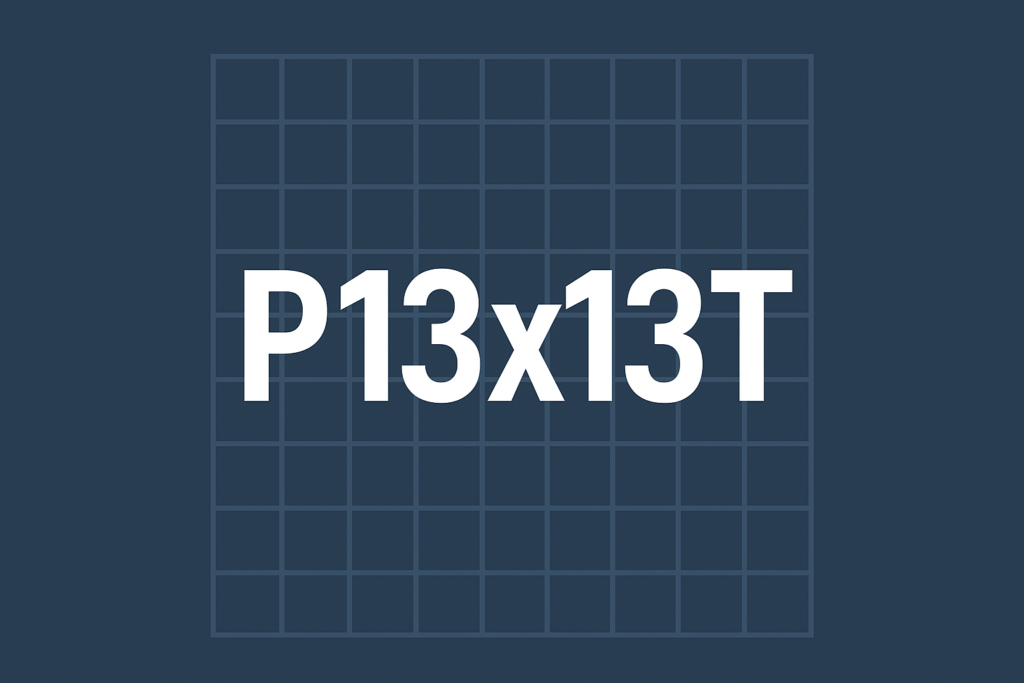Introduction
In today’s rapidly advancing world of engineering and innovation, P13x13T has emerged as a breakthrough term capturing the attention of technologists, engineers, and digital innovators alike. Though it may sound cryptic at first glance, P13x13T represents a new class of precision technology—an integrated framework that combines smart architecture, compact design, and performance adaptability. The name itself hints at structure and efficiency: “P” often denotes precision, while “13×13” implies a scalable, grid-based model that can be customized for multiple industrial or computational applications.
The rise of P13x13T comes at a time when businesses demand high-efficiency systems that don’t compromise on power or flexibility. Whether it’s applied to data architecture, advanced chip design, robotics, or intelligent automation, P13x13T serves as a modular foundation that drives consistent, measurable results. Think of it as the invisible backbone that helps machines, algorithms, and infrastructures communicate seamlessly and function optimally.
This article dives deep into the concept, structure, and impact of P13x13T—exploring how it works, its potential applications, and what makes it a game-changer in modern innovation. From manufacturing optimization to next-gen computing, we’ll unpack why P13x13T has become synonymous with performance, precision, and progress.
What Is P13x13T and Why It Matters
At its core, P13x13T is a framework built to enhance system stability and scalability across multiple environments. It blends compact geometric design with intelligent functionality, allowing it to adapt to complex systems without requiring extensive reconfiguration. Think of P13x13T as an adaptable core—one that bridges physical and digital domains for improved alignment and execution. Its modular layout provides balance between strength and flexibility, which is why it’s gaining traction in sectors like AI development, sensor design, and embedded computing.
Why does this matter? Because modern industries face mounting pressure to deliver faster, smarter, and more efficient outcomes. P13x13T offers a pathway toward that goal. By integrating precision mapping and resource optimization, it minimizes performance lag while enhancing throughput. The result is a balanced system that can handle high workloads while maintaining consistent energy efficiency. In short, P13x13T isn’t just another technological acronym—it’s a blueprint for next-generation infrastructure.
The Architecture Behind P13x13T
The structural layout of P13x13T follows a methodical, matrix-like design. Each segment in the 13×13 grid serves a distinct purpose, optimizing flow between interconnected units. This pattern reduces redundancy and maximizes spatial efficiency—two elements that are crucial for systems operating at scale. Engineers often compare the P13x13T layout to a neural network, where every node contributes to overall performance. This interdependence ensures that even if one section experiences load fluctuations, the rest can dynamically compensate to maintain stability.
From a practical standpoint, the architecture of P13x13T enhances modular adaptability. This allows developers to integrate new functions without overhauling existing infrastructure. The design fosters long-term sustainability by reducing material waste and system inefficiency. Furthermore, its grid pattern supports predictive diagnostics, meaning it can anticipate maintenance needs before breakdowns occur. Whether implemented in microprocessors or industrial control systems, the P13x13T architecture delivers unmatched reliability.
P13x13T in Advanced Manufacturing
The manufacturing sector has embraced P13x13T for its ability to optimize production lines and enhance precision engineering. Using its structured grid, manufacturers can create synchronized workflows, reducing human error and machine downtime. For example, in automotive assembly or aerospace fabrication, the P13x13T framework enables faster calibration between robotic units, ensuring each component meets exact specifications. The result? Higher throughput, tighter tolerances, and reduced rework costs.
Beyond efficiency, P13x13T promotes sustainability. Because of its modular layout, factories can reconfigure operations quickly to meet changing demands without major capital expenditure. This flexibility aligns with the growing trend of smart manufacturing, where digital twins and real-time data analytics guide production. By leveraging P13x13T, companies can adapt to market fluctuations with minimal disruption—an invaluable advantage in today’s competitive global market.
Applications of P13x13T in Computing and AI
Within computing and artificial intelligence, P13x13T acts as a performance multiplier. It’s especially valuable in data-heavy environments where processing power and coordination are critical. The framework allows AI models to run more efficiently by optimizing how data packets move through processing layers. In deep learning, this reduces training time and energy consumption, two major barriers in large-scale AI deployment.
Moreover, the adaptive design of P13x13T enhances machine learning precision. Systems built on this framework can recalibrate themselves in real time, adjusting for shifting parameters or incoming data variations. This self-optimizing behavior translates to smarter algorithms and faster insights. In industries ranging from healthcare to autonomous vehicles, P13x13T is redefining what’s possible with compact, high-performance computational design.
The Role of P13x13T in Smart Infrastructure
Urban infrastructure is evolving, and P13x13T is emerging as a key enabler of intelligent cities. Through its efficient grid-based design, it supports the seamless integration of IoT devices, sensors, and data management systems. When applied to traffic control, energy distribution, or building automation, P13x13T provides the structural intelligence needed to manage vast networks of information. This translates to smarter cities with reduced energy waste and improved operational coordination.
Equally important is the role of P13x13T in predictive analytics. Its systematic organization allows infrastructure systems to detect anomalies early, preventing costly breakdowns. Cities adopting P13x13T-based solutions are seeing measurable improvements in maintenance cycles, safety management, and service delivery. The framework’s scalability ensures it can grow alongside urban populations, making it a sustainable choice for future-ready infrastructure.
Benefits of Implementing P13x13T
Implementing P13x13T brings multiple strategic benefits. First, it dramatically improves operational efficiency through precision alignment and load distribution. Systems experience less strain because resources are allocated where they’re needed most. Second, P13x13T enhances data integrity, ensuring that every component communicates clearly within the network. This reduces errors and increases transparency across all levels of operation.
In addition, businesses adopting P13x13T report measurable ROI improvements. From cost savings in maintenance to faster deployment of new technologies, the framework delivers both short- and long-term gains. By combining adaptability with precision, P13x13T allows organizations to innovate without risk—future-proofing their systems in an era where technology evolves daily.
Challenges and Considerations for P13x13T Integration
Despite its many advantages, implementing P13x13T requires thoughtful planning. One key challenge lies in aligning legacy systems with the grid-based structure. Organizations must ensure that existing data pipelines and hardware are compatible with P13x13T’s modular logic. This often involves phased deployment strategies and targeted retraining for technical staff.
Another consideration is cybersecurity. Because P13x13T operates across interconnected nodes, protecting each layer is essential to maintaining overall integrity. Robust encryption, authentication, and access management are critical. Companies that address these concerns upfront will find that P13x13T integration yields long-lasting stability and unmatched precision in operation.
The Future of P13x13T Technology
As industries continue to prioritize intelligent automation, P13x13T is set to play a pivotal role. Its potential extends beyond current applications into areas like quantum computing, bioengineering, and next-gen robotics. By combining structured geometry with adaptive intelligence, it paves the way for a new standard of efficiency and resilience. The ongoing evolution of P13x13T signals a shift from static infrastructure to dynamic ecosystems capable of learning, adapting, and improving continuously.
We can expect to see more companies leveraging P13x13T in hybrid models—merging physical and digital systems for optimal performance. Its influence on design principles, system architecture, and energy optimization will only deepen over time. In essence, P13x13T is not just a framework—it’s a philosophy of precision and balance shaping the future of technological innovation.
Conclusion
The era of P13x13T marks a defining moment in precision-driven innovation. What began as a conceptual framework has evolved into a cornerstone of modern engineering and digital transformation. By uniting structure, intelligence, and adaptability, P13x13T empowers industries to achieve levels of efficiency once thought impossible. From manufacturing to smart cities, its impact is both measurable and meaningful.
For forward-thinking organizations, embracing P13x13T isn’t merely a technical decision—it’s a strategic advantage. It represents a commitment to smarter design, sustainable progress, and future-readiness. As we move deeper into an age defined by data and automation, P13x13T will remain a guiding force—proof that precision and innovation can coexist in perfect harmony.







